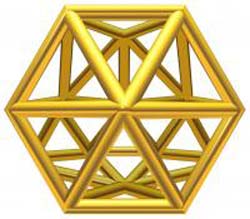Buckyballs make room for gilded cages

Au16, the world’s smallest hollow gold cage.
Carbon fullerenes now have metallic cousins, ‘hollow golden cages’
Scientists have uncovered a class of gold atom clusters that are the first known metallic hollow equivalents of the famous hollow carbon fullerenes known as buckyballs.
The evidence for what their discoverers call “hollow golden cages” appeared today in the online early edition of the Proceedings of the National Academy of Sciences.
The fullerene is made up of a sphere of 60 carbon (C) atoms; gold (Au) requires many fewer–16, 17 and 18 atoms, in triangular configurations more gem-like than soccer ball. At more than 6 angstroms across, or roughly a ten-millionth the size of this comma, they are nonetheless roomy enough to cage a smaller atom.
“This is the first time that a hollow cage made of metal has been experimentally proved,” said Lai-Sheng Wang, the paper’s lead corresponding author.
Wang is an affiliate senior chief scientist at the Department of Energy’s Pacific Northwest National Laboratory and professor of physics at Washington State University. The experiments were buttressed and the clusters’ geometry deciphered from theoretical calculations led by Professor Xiao Cheng Zeng of the University of Nebraska and co-corresponding author.
Wang, who worked in the Richard Smalley lab that gave the world buckyballs, is part of a large cluster of researchers who have spent much of the past decade attempting to find the fullerene’s kin in metal. But their search has proved difficult because of metal clusters’ tendency to compact or flatten.
Experiments at the PNNL-based W.R. Wiley Environmental Molecular Sciences Laboratory elicited the photoelectron spectra of clusters smaller than Au32, which had been theorized as the gold-cage analog to C60 but ruled out by Wang’s group in an experiment that showed it as being a compact clump.
They instead turned their attention to clusters smaller than 20 atoms, which earlier work by Wang’s group showed were 3-D– a golden pyramid, no less–but larger than 13 atoms, known to be flat. The spectra and calculations showed that clusters of 15 atoms or fewer remained flat but that all but one possible configuration of 16, 17 and 18 atoms open in the middle. At 19 atoms, the spaces fill in again to form a near-pyramid.
“Au-16 is beautiful and can be viewed as the smallest golden cage,” Wang said. He pictures it as having “removed the four corner atoms from our Au20 pyramid and then letting the remaining atoms relax a little,” and thus opening up space in its center.
It and its larger neighbors are stable at room temperature and are known as “free-standing” cages–unattached to a surface or any other body, in a vacuum. “When deposited on a surface, the cluster may interact with the surface and the structure may change.”
Wang and his co-workers suspect “that many different kinds of atoms can be trapped inside” these hollow clusters, a process called “doping.” “These doped cages may very well survive on surfaces,” suggesting a method for influencing physical and chemical properties at smaller-than-nano scales, “depending on the dopants.”
Wang’s group has not yet attempted to imprison a foreign atom in the hollow Au cages, but they plan to try.
Media Contact
More Information:
http://www.pnl.govAll latest news from the category: Physics and Astronomy
This area deals with the fundamental laws and building blocks of nature and how they interact, the properties and the behavior of matter, and research into space and time and their structures.
innovations-report provides in-depth reports and articles on subjects such as astrophysics, laser technologies, nuclear, quantum, particle and solid-state physics, nanotechnologies, planetary research and findings (Mars, Venus) and developments related to the Hubble Telescope.
Newest articles

First-of-its-kind study uses remote sensing to monitor plastic debris in rivers and lakes
Remote sensing creates a cost-effective solution to monitoring plastic pollution. A first-of-its-kind study from researchers at the University of Minnesota Twin Cities shows how remote sensing can help monitor and…

Laser-based artificial neuron mimics nerve cell functions at lightning speed
With a processing speed a billion times faster than nature, chip-based laser neuron could help advance AI tasks such as pattern recognition and sequence prediction. Researchers have developed a laser-based…

Optimising the processing of plastic waste
Just one look in the yellow bin reveals a colourful jumble of different types of plastic. However, the purer and more uniform plastic waste is, the easier it is to…


